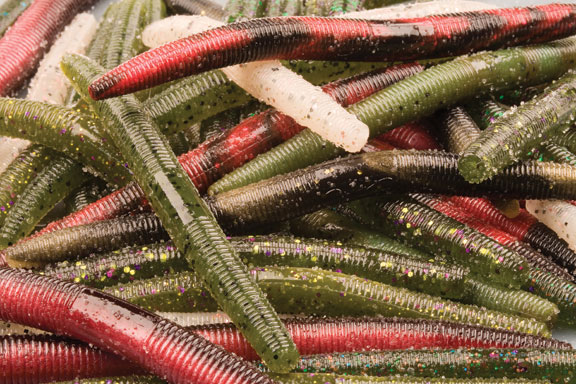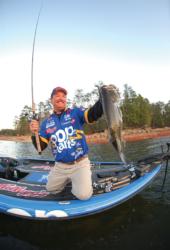Rules of the soft stick
If you haven’t tried a soft stickbait in the last few years, you’re in a select group

You really can’t blame Oklahoma’s Sam Newby, a member of the Kellogg’s team, for being slow to catch on to soft stickbaits. After all, the Senko and its many imitators are some of the most inane looking lures ever created. These slightly tapered cylinders have only shallow rings to give them any character. They have no skirts, swimming tails, craw pincers, wings or other appendages to jazz them up.
Even Wal-Mart FLW Tour veteran Gary Yamamoto, the Senko’s inventor, didn’t know what he had when he put the lure on the market. He originally designed it to be used like a Slug-Go soft jerkbait. Then bass fishermen experimented with the Senko and found that it sinks horizontally with a subtle wobble on a slack line. The action was unlike anything bass had ever seen. They couldn’t resist it, even when they were in a funk and shunned other soft plastics. Similar baits quickly followed: Berkley Sinking Minnow, Kinami Flash, Yum Dinger.
Newby finally got hooked on the soft stickbait during a January 2002 FLW Tour event on Lake Okeechobee. He was flipping a tube to scattered vegetation while his co-angler cast a Senko behind him.
“My partner had a limit before I caught my first bass,” Newby said. “I eventually caught a heavier limit than he did on my tube, but he showed me that the Senko is a serious weapon. Now it’s one of my top three bass producers, along with jigs and spinnerbaits.”
When Newby fishes a Senko, he rigs the 5-inch size Texas style without a weight 90 percent of the time. If bass are line shy, he matches the Senko with a 2/0 superline worm hook and 10-pound-test Berkley Vanish fluorocarbon line. But, he misses fewer strikes when bass will tolerate a 4/0 hook and 20-pound line.
 Newby casts the Senko to any shallow cover that holds bass, such as visible aquatic vegetation, laydowns, boat docks and submerged grass that tops out as deep as 6 feet or so beneath the surface. He claims a Senko without a weight also skips nicely under docks and overhanging branches. “The Senko works best for me in clear water, but I catch bass with it in stained water, too,” he said. “The watermelon-red color works about anywhere.”
Newby casts the Senko to any shallow cover that holds bass, such as visible aquatic vegetation, laydowns, boat docks and submerged grass that tops out as deep as 6 feet or so beneath the surface. He claims a Senko without a weight also skips nicely under docks and overhanging branches. “The Senko works best for me in clear water, but I catch bass with it in stained water, too,” he said. “The watermelon-red color works about anywhere.”
After casting the Senko, Newby holds his rod level with the water and points it nearly 90 degrees to the side of the bait. He lets the line sag to the water in a loose bow so the Senko can free fall without any resistance. This is when the bait wobbles and works its magic. Since he can’t feel bites with this presentation, Newby watches the line for the telltale jump that indicates a strike. The strike may come on the initial fall or when the bait rests on the bottom.
“I normally dead-stick the bait for 30 to 45 seconds,” Newby said. “A lot of bass swim over and look at it, and they will finally have to take a taste of it.”
The action Newby imparts to the bait after a dead-sticking session depends on the mood of the bass. On some days, he must drag the Senko very slowly with a sideways sweep of the rod and dead-stick it again. At other times, bass respond better to a twitch or two before the bait sinks back to the bottom. If he’s casting to cover, such as a laydown or flooded bush, Newby retrieves the bait after two or three sinks. When fishing over submerged grass, he continues the sweep-dead-stick routine until the Senko falls off the edge of the grass line.
Wacky rigging
Fishing a soft stickbait wacky style gets more bites for Newby than a Texas rig when prespawn bass cruise the shallows just beneath the surface. “The first bass to come up and cruise are real wary,” Newby said. “If you throw a wacky worm way out ahead of them, they’ll swim over and smash it. I work a wacky rig with twitches and short pauses, and I never let it get out of sight.”
Newby prefers bright, highly visible colors for wacky rigging, including chartreuse, white and merthiolate. He opts for a 2/0 Gamakatsu Finesse Wide Gap hook because it has a monofilament weed guard.
The drawback with wacky rigging is that the bait often tears apart after its first meeting with a bass. You can increase the life of soft stickbaits with a trick devised by Texas bass pro Alton Jones. He spreads a 1/4-inch O-ring with needle-nose pliers and slips a 5-inch YUM Dinger halfway through the opening. When the pliers are removed, the Dinger wears the O-Ring like a snug belt. Jones slips a 3/0 live-bait hook under the O-Ring without penetrating the plastic. He claims he has caught as many as 30 bass on one Dinger with this rig.
Adding weight
When the wind kicks up and prevents the Senko’s horizontal fall, Newby continues to fish the bait effectively by pegging a black 1/16- or 1/8-ounce Tru-Tungsten bullet sinker to the nose of the bait. Yamamoto often adds a 1/16- or 1/8-ounce Gambler screw-in Florida Rig sinker to give his Senko a faster fall or to get it deeper.
The Florida Rig came through for Yamamoto when he pitched a 5-inch Senko to dock pilings during the June 2005 FLW Tour event on the Potomac River. Some of the pilings were anchored in 6 to 8 feet of water. The Senko sank too slowly without a weight. After pitching his bait next to a piling, Yamamoto let it fall to the bottom on a slack line, just as he does when he fishes a Senko without a weight. The result  was an eighth-place finish.
was an eighth-place finish.
“When you free-line a Senko that has a little weight in its nose, it swims down with a spiraling fall,” Yamamoto said.
A weighted, spiraling Senko has duped bass across the country for Yamamoto. At the Wal-Mart Open on Beaver Lake, he plucked suspended spotted bass from the limbs of submerged trees standing in 25 to 40 feet of water. A 5-inch Senko, his mainstay, did the trick in that tournament, but Yamamoto occasionally downsizes to a 4-inch Senko when fishing for spotted bass and smallmouth bass. He rarely uses other sizes.
Whether he fishes the Senko with or without a weight, Yamamoto rigs it with a 5/0 worm hook. He misses fewer bass with an off-set round-bend hook when he’s flipping, pitching and power setting on a short line. When he casts a Senko, Yamamoto switches to an off-set extra-wide-gap hook, which he claims does better with a “pressure” hook set.
You can maintain a soft stickbait’s alluring horizontal fall and increase its sink rate by rigging it with a hook that has a weight attached to its shaft. Mustad’s Power Lock Plus has a barbed plastic keeper that pushes into the nose of the bait, and you can slide its weight on the hook’s shank to get the balance you want. The wire keeper on Daiichi’s red Butt Dragger hook screws into the nose of the bait. The weight can be moved forward and cut to custom size.
You can also change the action of a soft stickbait by adding a weight to its tail. Todd Faircloth of Jasper, Texas, pushes a 1 1/4-inch No. 3 finish nail into the tail. This makes the bait sink tail first and drift backward, so it stays in the strike zone longer.
 Whatever the rigging, many fishermen wonder why bass find the soft stickbait so irresistible. “I wish I knew,” Newby said. “It’s the ugliest bait ever made, but it works so well.”
Whatever the rigging, many fishermen wonder why bass find the soft stickbait so irresistible. “I wish I knew,” Newby said. “It’s the ugliest bait ever made, but it works so well.”
The pressure set
Gary Yamamoto slams bass with the conventional cross-their-eyes hookset when he flips and pitches a Senko, but he never sets the hook when he casts the bait. He lands more bass with a casting presentation by letting the bass set the hook for him. As a bass swims off with his Senko, Yamamoto lets the line tighten and simply maintains steady pressure. He calls this a “pressure set.”
“You tell a bass pro not to set the hook, and most of them will go crazy,” Yamamoto said. “But, the successful fishermen do it. When the bass feels the hook grab him, he is already hooked.
“Try it sometime when you are not in a tournament. If you don’t set the hook and just keep pressure on the bass, you won’t be able to take the bait away from him.”